ESP CHRYSLER VOYAGER 2001 Service Manual
[x] Cancel search | Manufacturer: CHRYSLER, Model Year: 2001, Model line: VOYAGER, Model: CHRYSLER VOYAGER 2001Pages: 4284, PDF Size: 83.53 MB
Page 3806 of 4284
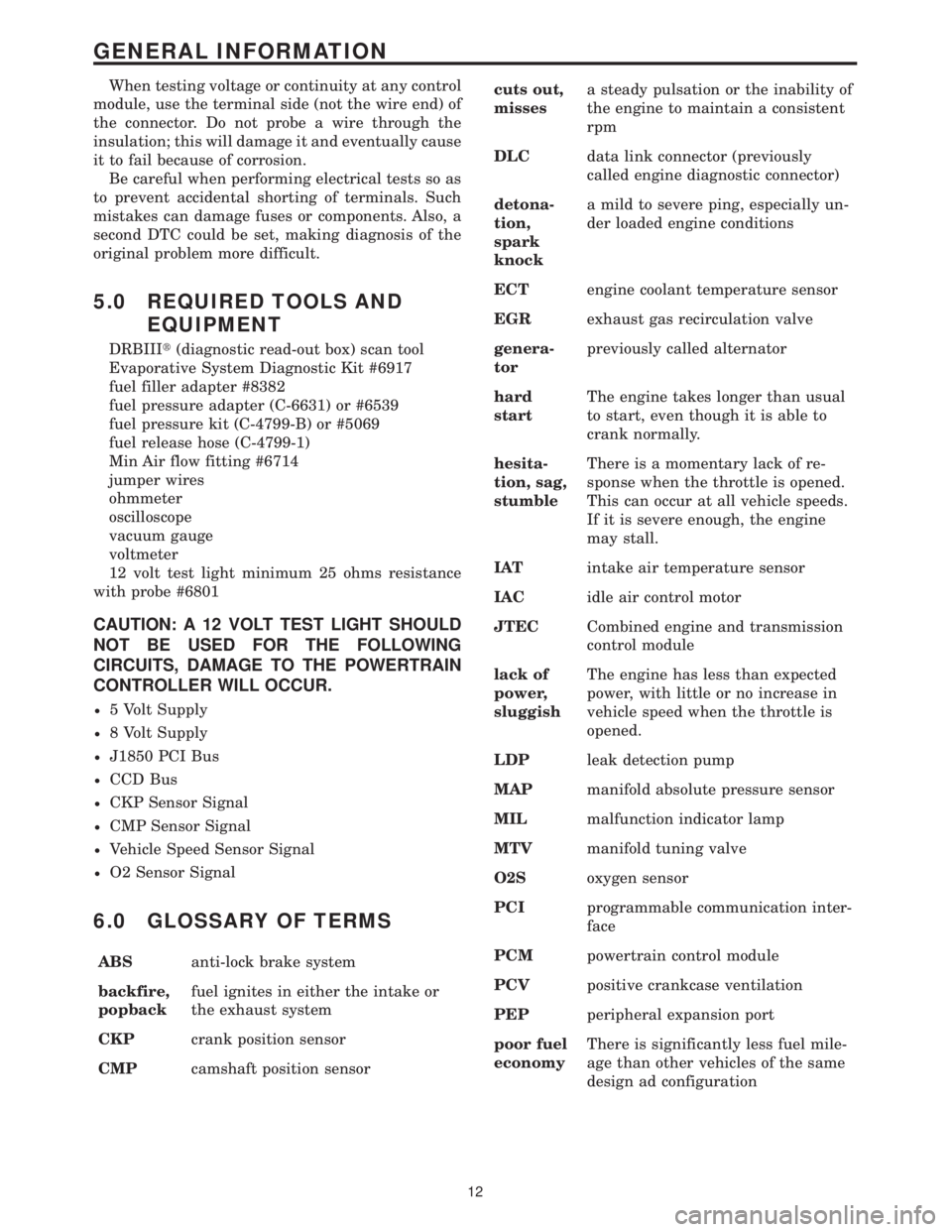
When testing voltage or continuity at any control
module, use the terminal side (not the wire end) of
the connector. Do not probe a wire through the
insulation; this will damage it and eventually cause
it to fail because of corrosion.
Be careful when performing electrical tests so as
to prevent accidental shorting of terminals. Such
mistakes can damage fuses or components. Also, a
second DTC could be set, making diagnosis of the
original problem more difficult.
5.0 REQUIRED TOOLS AND
EQUIPMENT
DRBIIIt(diagnostic read-out box) scan tool
Evaporative System Diagnostic Kit #6917
fuel filler adapter #8382
fuel pressure adapter (C-6631) or #6539
fuel pressure kit (C-4799-B) or #5069
fuel release hose (C-4799-1)
Min Air flow fitting #6714
jumper wires
ohmmeter
oscilloscope
vacuum gauge
voltmeter
12 volt test light minimum 25 ohms resistance
with probe #6801
CAUTION: A 12 VOLT TEST LIGHT SHOULD
NOT BE USED FOR THE FOLLOWING
CIRCUITS, DAMAGE TO THE POWERTRAIN
CONTROLLER WILL OCCUR.
²5 Volt Supply
²8 Volt Supply
²J1850 PCI Bus
²CCD Bus
²CKP Sensor Signal
²CMP Sensor Signal
²Vehicle Speed Sensor Signal
²O2 Sensor Signal
6.0 GLOSSARY OF TERMS
ABSanti-lock brake system
backfire,
popbackfuel ignites in either the intake or
the exhaust system
CKPcrank position sensor
CMPcamshaft position sensorcuts out,
missesa steady pulsation or the inability of
the engine to maintain a consistent
rpm
DLCdata link connector (previously
called engine diagnostic connector)
detona-
tion,
spark
knocka mild to severe ping, especially un-
der loaded engine conditions
ECTengine coolant temperature sensor
EGRexhaust gas recirculation valve
genera-
torpreviously called alternator
hard
startThe engine takes longer than usual
to start, even though it is able to
crank normally.
hesita-
tion, sag,
stumbleThere is a momentary lack of re-
sponse when the throttle is opened.
This can occur at all vehicle speeds.
If it is severe enough, the engine
may stall.
IATintake air temperature sensor
IACidle air control motor
JTECCombined engine and transmission
control module
lack of
power,
sluggishThe engine has less than expected
power, with little or no increase in
vehicle speed when the throttle is
opened.
LDPleak detection pump
MAPmanifold absolute pressure sensor
MILmalfunction indicator lamp
MTVmanifold tuning valve
O2Soxygen sensor
PCIprogrammable communication inter-
face
PCMpowertrain control module
PCVpositive crankcase ventilation
PEPperipheral expansion port
poor fuel
economyThere is significantly less fuel mile-
age than other vehicles of the same
design ad configuration
12
GENERAL INFORMATION
Page 3807 of 4284

rough,
unstable,
or er-
ratic idle
stallingThe engine runs unevenly at idle
and causes the engine to shake if it
is severe enough. The engine idle
rpm may vary (called hunting). This
condition may cause stalling if it is
severe enough.
SBECsingle board engine controller
SKIMsentry key immobilizer module
SKISsentry key immobilizer systemstart &
stallThe engine starts but immediately
dies.
surgeengine rpm fluctuation without cor-
responding change in throttle posi-
tion sensor
TPSthrottle position sensor
TRStransmission range sensor
VSSvehicle speed sensor/signal
13
GENERAL INFORMATION
Page 3830 of 4284
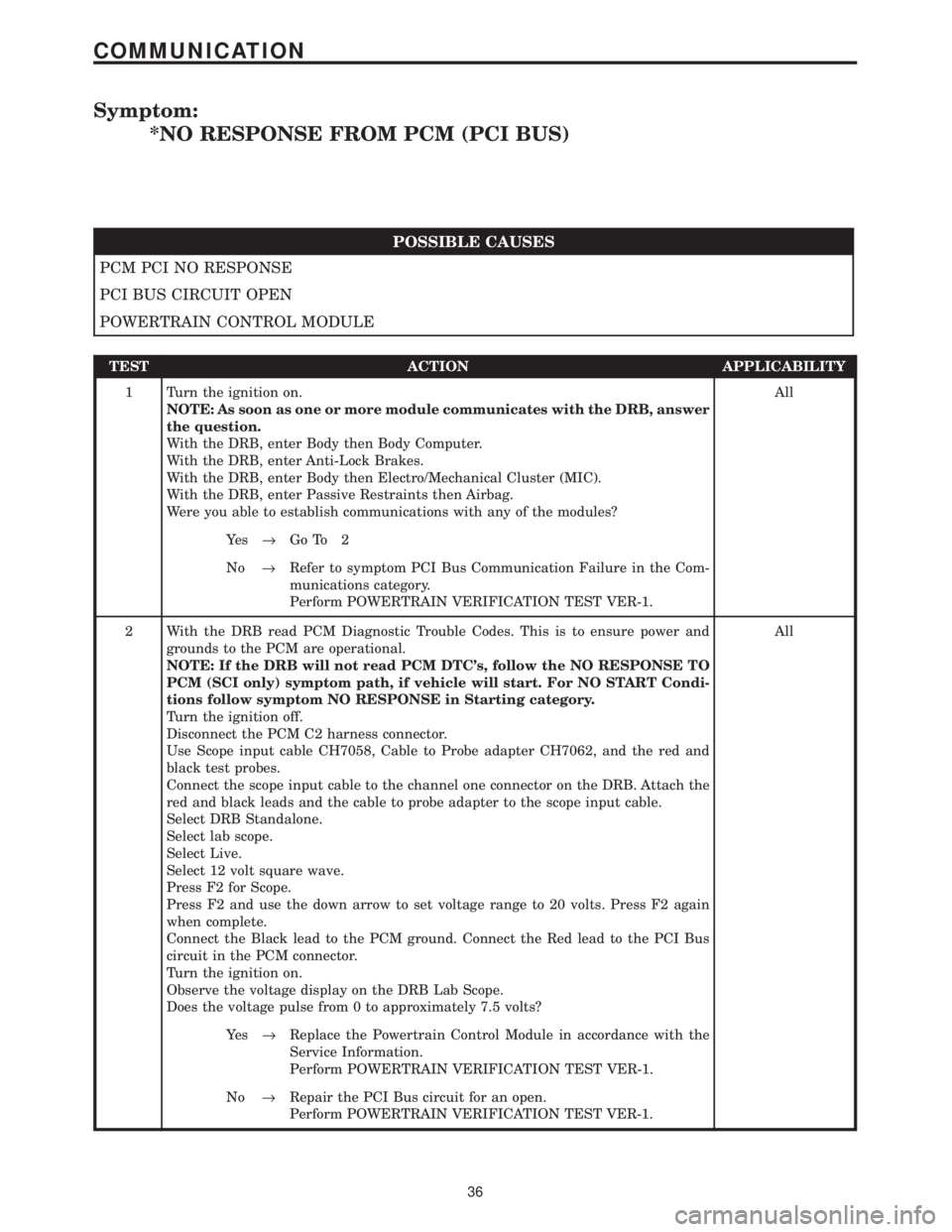
Symptom:
*NO RESPONSE FROM PCM (PCI BUS)
POSSIBLE CAUSES
PCM PCI NO RESPONSE
PCI BUS CIRCUIT OPEN
POWERTRAIN CONTROL MODULE
TEST ACTION APPLICABILITY
1 Turn the ignition on.
NOTE: As soon as one or more module communicates with the DRB, answer
the question.
With the DRB, enter Body then Body Computer.
With the DRB, enter Anti-Lock Brakes.
With the DRB, enter Body then Electro/Mechanical Cluster (MIC).
With the DRB, enter Passive Restraints then Airbag.
Were you able to establish communications with any of the modules?All
Ye s®Go To 2
No®Refer to symptom PCI Bus Communication Failure in the Com-
munications category.
Perform POWERTRAIN VERIFICATION TEST VER-1.
2 With the DRB read PCM Diagnostic Trouble Codes. This is to ensure power and
grounds to the PCM are operational.
NOTE: If the DRB will not read PCM DTC's, follow the NO RESPONSE TO
PCM (SCI only) symptom path, if vehicle will start. For NO START Condi-
tions follow symptom NO RESPONSE in Starting category.
Turn the ignition off.
Disconnect the PCM C2 harness connector.
Use Scope input cable CH7058, Cable to Probe adapter CH7062, and the red and
black test probes.
Connect the scope input cable to the channel one connector on the DRB. Attach the
red and black leads and the cable to probe adapter to the scope input cable.
Select DRB Standalone.
Select lab scope.
Select Live.
Select 12 volt square wave.
Press F2 for Scope.
Press F2 and use the down arrow to set voltage range to 20 volts. Press F2 again
when complete.
Connect the Black lead to the PCM ground. Connect the Red lead to the PCI Bus
circuit in the PCM connector.
Turn the ignition on.
Observe the voltage display on the DRB Lab Scope.
Does the voltage pulse from 0 to approximately 7.5 volts?All
Ye s®Replace the Powertrain Control Module in accordance with the
Service Information.
Perform POWERTRAIN VERIFICATION TEST VER-1.
No®Repair the PCI Bus circuit for an open.
Perform POWERTRAIN VERIFICATION TEST VER-1.
36
COMMUNICATION
Page 3831 of 4284
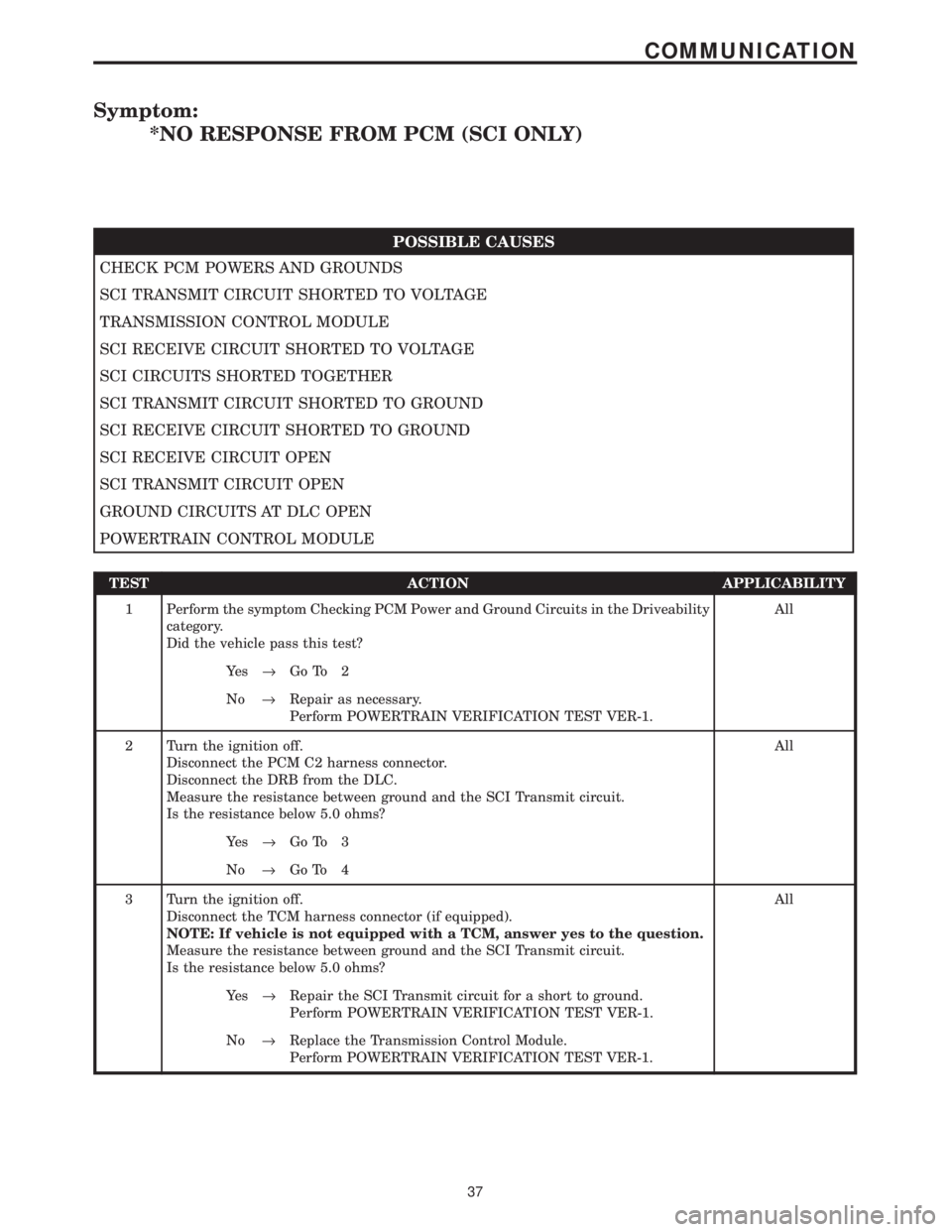
Symptom:
*NO RESPONSE FROM PCM (SCI ONLY)
POSSIBLE CAUSES
CHECK PCM POWERS AND GROUNDS
SCI TRANSMIT CIRCUIT SHORTED TO VOLTAGE
TRANSMISSION CONTROL MODULE
SCI RECEIVE CIRCUIT SHORTED TO VOLTAGE
SCI CIRCUITS SHORTED TOGETHER
SCI TRANSMIT CIRCUIT SHORTED TO GROUND
SCI RECEIVE CIRCUIT SHORTED TO GROUND
SCI RECEIVE CIRCUIT OPEN
SCI TRANSMIT CIRCUIT OPEN
GROUND CIRCUITS AT DLC OPEN
POWERTRAIN CONTROL MODULE
TEST ACTION APPLICABILITY
1 Perform the symptom Checking PCM Power and Ground Circuits in the Driveability
category.
Did the vehicle pass this test?All
Ye s®Go To 2
No®Repair as necessary.
Perform POWERTRAIN VERIFICATION TEST VER-1.
2 Turn the ignition off.
Disconnect the PCM C2 harness connector.
Disconnect the DRB from the DLC.
Measure the resistance between ground and the SCI Transmit circuit.
Is the resistance below 5.0 ohms?All
Ye s®Go To 3
No®Go To 4
3 Turn the ignition off.
Disconnect the TCM harness connector (if equipped).
NOTE: If vehicle is not equipped with a TCM, answer yes to the question.
Measure the resistance between ground and the SCI Transmit circuit.
Is the resistance below 5.0 ohms?All
Ye s®Repair the SCI Transmit circuit for a short to ground.
Perform POWERTRAIN VERIFICATION TEST VER-1.
No®Replace the Transmission Control Module.
Perform POWERTRAIN VERIFICATION TEST VER-1.
37
COMMUNICATION
Page 3832 of 4284
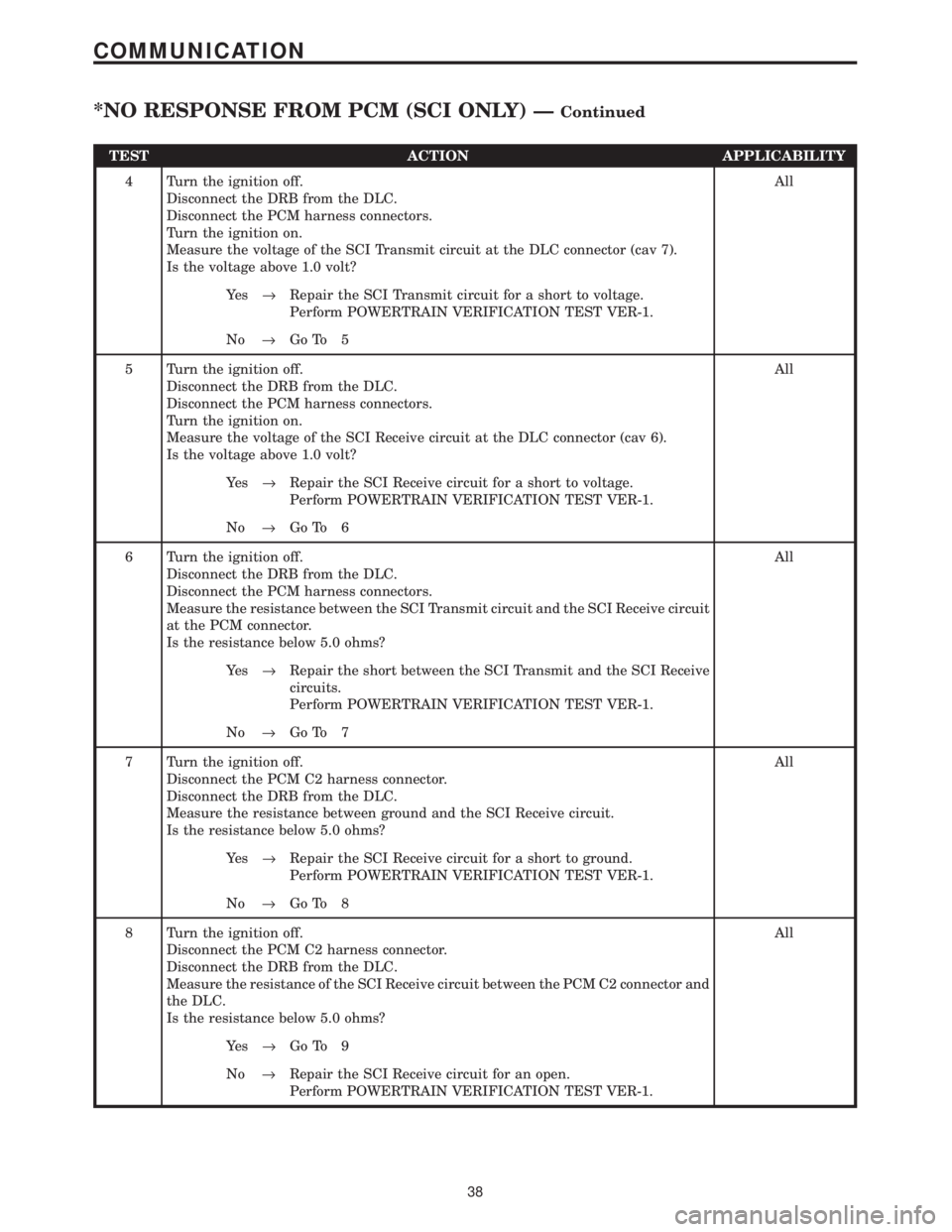
TEST ACTION APPLICABILITY
4 Turn the ignition off.
Disconnect the DRB from the DLC.
Disconnect the PCM harness connectors.
Turn the ignition on.
Measure the voltage of the SCI Transmit circuit at the DLC connector (cav 7).
Is the voltage above 1.0 volt?All
Ye s®Repair the SCI Transmit circuit for a short to voltage.
Perform POWERTRAIN VERIFICATION TEST VER-1.
No®Go To 5
5 Turn the ignition off.
Disconnect the DRB from the DLC.
Disconnect the PCM harness connectors.
Turn the ignition on.
Measure the voltage of the SCI Receive circuit at the DLC connector (cav 6).
Is the voltage above 1.0 volt?All
Ye s®Repair the SCI Receive circuit for a short to voltage.
Perform POWERTRAIN VERIFICATION TEST VER-1.
No®Go To 6
6 Turn the ignition off.
Disconnect the DRB from the DLC.
Disconnect the PCM harness connectors.
Measure the resistance between the SCI Transmit circuit and the SCI Receive circuit
at the PCM connector.
Is the resistance below 5.0 ohms?All
Ye s®Repair the short between the SCI Transmit and the SCI Receive
circuits.
Perform POWERTRAIN VERIFICATION TEST VER-1.
No®Go To 7
7 Turn the ignition off.
Disconnect the PCM C2 harness connector.
Disconnect the DRB from the DLC.
Measure the resistance between ground and the SCI Receive circuit.
Is the resistance below 5.0 ohms?All
Ye s®Repair the SCI Receive circuit for a short to ground.
Perform POWERTRAIN VERIFICATION TEST VER-1.
No®Go To 8
8 Turn the ignition off.
Disconnect the PCM C2 harness connector.
Disconnect the DRB from the DLC.
Measure the resistance of the SCI Receive circuit between the PCM C2 connector and
the DLC.
Is the resistance below 5.0 ohms?All
Ye s®Go To 9
No®Repair the SCI Receive circuit for an open.
Perform POWERTRAIN VERIFICATION TEST VER-1.
38
COMMUNICATION
*NO RESPONSE FROM PCM (SCI ONLY) ÐContinued
Page 3833 of 4284

TEST ACTION APPLICABILITY
9 Turn the ignition off.
Disconnect the PCM C2 harness connector.
Disconnect the DRB from the DLC.
Measure the resistance of the SCI Transmit circuit between the PCM C2 connector
and the DLC.
Is the resistance below 5.0 ohms?All
Ye s®Go To 10
No®Repair the SCI Transmit circuit for an open.
Perform POWERTRAIN VERIFICATION TEST VER-1.
10 Turn the ignition off.
Disconnect the DRB from the DLC.
Disconnect the negative battery cable.
Measure the resistance between ground and both ground circuits at the DLC.
Is the resistance below 5.0 ohms for each measurement?All
Ye s®Go To 11
No®Repair the ground circuit that measured above 5.0 ohms for an
open.
Perform POWERTRAIN VERIFICATION TEST VER-1.
11 If there are no possible causes remaining, view repair. All
Repair
Replace and program the Powertrain Control Module in accor-
dance with the Service Information.
Perform POWERTRAIN VERIFICATION TEST VER-1.
39
COMMUNICATION
*NO RESPONSE FROM PCM (SCI ONLY) ÐContinued
Page 3834 of 4284

Symptom:
*PCI BUS COMMUNICATION FAILURE
POSSIBLE CAUSES
WITH THE DRB PERFORM A MODULE SCAN
OPEN PCI BUS CIRCUIT AT THE DATA LINK CONNECTOR
USING THE DRB, PERFORM THE PCI BUS CONTROL MODE
DISCONNECT THE MODULE(S) HARNESS CONNECTOR
PCI BUS CIRCUIT SHORTED TO VOLTAGE
DISCONNECT THE MODULE(S) HARNESS CONNECTOR
PCI BUS CIRCUIT SHORTED TO GROUND
WIRING HARNESS INTERMITTENT FAILURE
TEST ACTION APPLICABILITY
1Note: Determine which modules this vehicle is equipped with before begin-
ning.
Connect the Diagnostic Junction Port Tester #8339 to the DRB and to the Diagnostic
Junction Port.
Using the DRB, along with the Diagnostic Junction Port Tester #8339, select
Junction Port Tool then PCI Bus Module Scan and follow the instructions on the
DRB.
Was the DRB able to scan (I/D or communicate) with any modules?All
Ye s®Refer to the Communication category for the related symptom(s).
(Individual module no responses).
Perform BODY VERIFICATION TEST - VER 1.
No®Go To 2
2 Turn the ignition off.
Measure the resistance of the PCI Bus circuit between the Data Link Connector and
the Diagnostic Junction Port connector.
Is the resistance below 5.0 ohms?All
Ye s®Go To 3
No®Repair the PCI Bus circuit for an open between the DLC and the
Diagnostic Junction Port.
Perform BODY VERIFICATION TEST - VER 1.
40
COMMUNICATION
Page 3835 of 4284
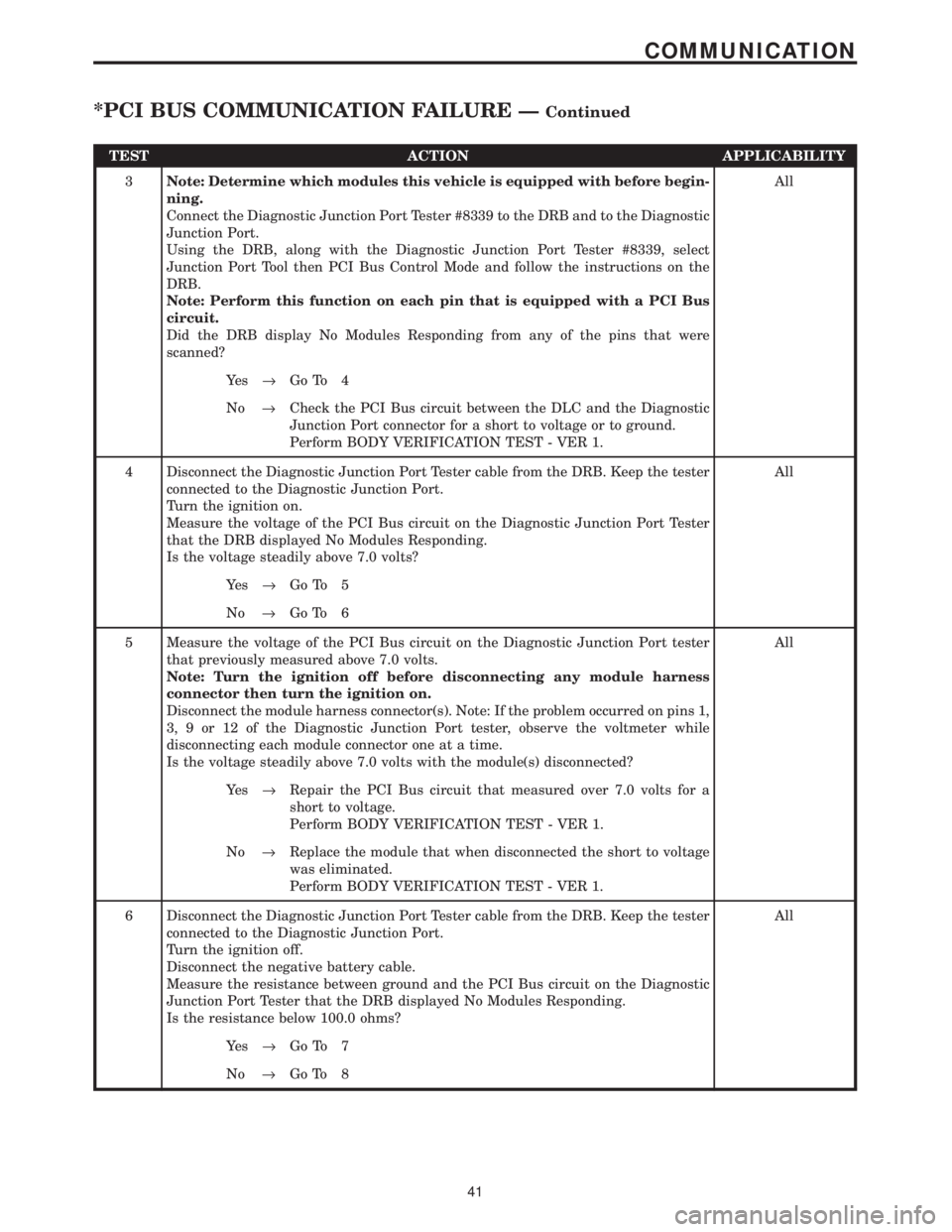
TEST ACTION APPLICABILITY
3Note: Determine which modules this vehicle is equipped with before begin-
ning.
Connect the Diagnostic Junction Port Tester #8339 to the DRB and to the Diagnostic
Junction Port.
Using the DRB, along with the Diagnostic Junction Port Tester #8339, select
Junction Port Tool then PCI Bus Control Mode and follow the instructions on the
DRB.
Note: Perform this function on each pin that is equipped with a PCI Bus
circuit.
Did the DRB display No Modules Responding from any of the pins that were
scanned?All
Ye s®Go To 4
No®Check the PCI Bus circuit between the DLC and the Diagnostic
Junction Port connector for a short to voltage or to ground.
Perform BODY VERIFICATION TEST - VER 1.
4 Disconnect the Diagnostic Junction Port Tester cable from the DRB. Keep the tester
connected to the Diagnostic Junction Port.
Turn the ignition on.
Measure the voltage of the PCI Bus circuit on the Diagnostic Junction Port Tester
that the DRB displayed No Modules Responding.
Is the voltage steadily above 7.0 volts?All
Ye s®Go To 5
No®Go To 6
5 Measure the voltage of the PCI Bus circuit on the Diagnostic Junction Port tester
that previously measured above 7.0 volts.
Note: Turn the ignition off before disconnecting any module harness
connector then turn the ignition on.
Disconnect the module harness connector(s). Note: If the problem occurred on pins 1,
3, 9 or 12 of the Diagnostic Junction Port tester, observe the voltmeter while
disconnecting each module connector one at a time.
Is the voltage steadily above 7.0 volts with the module(s) disconnected?All
Ye s®Repair the PCI Bus circuit that measured over 7.0 volts for a
short to voltage.
Perform BODY VERIFICATION TEST - VER 1.
No®Replace the module that when disconnected the short to voltage
was eliminated.
Perform BODY VERIFICATION TEST - VER 1.
6 Disconnect the Diagnostic Junction Port Tester cable from the DRB. Keep the tester
connected to the Diagnostic Junction Port.
Turn the ignition off.
Disconnect the negative battery cable.
Measure the resistance between ground and the PCI Bus circuit on the Diagnostic
Junction Port Tester that the DRB displayed No Modules Responding.
Is the resistance below 100.0 ohms?All
Ye s®Go To 7
No®Go To 8
41
COMMUNICATION
*PCI BUS COMMUNICATION FAILURE ÐContinued
Page 3853 of 4284

Symptom:
P0121-TPS VOLTAGE DOES NOT AGREE WITH MAP
When Monitored and Set Condition:
P0121-TPS VOLTAGE DOES NOT AGREE WITH MAP
When Monitored: With the engine running and no MAP Sensor or TP Sensor DTC's set.
Engine speed must be greater than 1600 RPM.
Set Condition: When the manifold vacuum is low, the TP sensor signal should be high.
Conversely, when manifold vacuum is high, the TP sensor signal should be low. If the MAP
Sensor and TP Sensor do not respond within 4 seconds as stated above, a DTC will be set.
POSSIBLE CAUSES
INTERMITTENT CONDITION
HIGH RESISTANCE IN 5 VOLT SUPPLY CIRCUIT
HIGH RESISTANCE TO GROUND IN 5 VOLT SUPPLY CIRCUIT
MAP SENSOR
HIGH RESISTANCE IN MAP SENSOR SIGNAL CIRCUIT
HIGH RESISTANCE TO GROUND IN MAP SENSOR SIGNAL CIRCUIT
HIGH RESISTANCE IN SENSOR GROUND CIRCUIT
PCM
HIGH RESISTANCE IN 5 VOLT SUPPLY CIRCUIT
HIGH RESISTANCE TO GROUND IN 5 VOLT SUPPLY CIRCUIT
TP SENSOR
HIGH RESISTANCE IN TP SENSOR SIGNAL CIRCUIT
HIGH RESISTANCE TO GROUND IN THROTTLE POSITION SENSOR SIGNAL CIRCUIT
HIGH RESISTANCE IN SENSOR GROUND CIRCUIT
PCM
TEST ACTION APPLICABILITY
1NOTE: Diagnose any TP Sensor or MAP Sensor component DTC first before
continuing.
NOTE: If the P0500 - No Vehicle Speed Signal is set long with this DTC, refer
to the P0500 diagnostics before continuing.
NOTE: The throttle plate and linkage should be free from binding and
carbon build up.
NOTE: Ensure the throttle plate is at the idle position.
Turn the ignition on.
With the DRBIIIt, read DTC's.
Is the Good Trip displayed and equal to zero?All
Ye s®Go To 2
No®Go To 18
59
DRIVEABILITY - GAS
Page 3873 of 4284

Symptom List:
P0133-1/1 O2 SENSOR SLOW RESPONSE
P0139-1/2 O2 SENSOR SLOW RESPONSE
Test Note: All symptoms listed above are diagnosed using the same tests.
The title for the tests will be P0133-1/1 O2 SENSOR SLOW
RESPONSE.
When Monitored and Set Condition:
P0133-1/1 O2 SENSOR SLOW RESPONSE
When Monitored: Start and drive vehicle greater than 10 MPH with throttle open for a
minimum 200 seconds. Coolant greater than 70ÉC (158ÉF). EVAP Purge is active. Test
performs in idle drive.
Set Condition: The oxygen sensor signal voltage is switching from below 0.39 volts to
above 0.58 volts and back fewer times than required in 60 seconds. Two trip fault..
P0139-1/2 O2 SENSOR SLOW RESPONSE
When Monitored: Start engine. Allow engine to idle. For 1st part of test, if limits are
exceeded, test passes. If not, 2nd part of test runs. Engine running for grater than 295
seconds. amb/batt temp >44ÉF, Baro >22.139HG, MAP >13.8 & <21.69HG, RPM >1400 &
<2500 (4cylinder) RPM > 1120 & <1950(6 cylinder) and vss >22 and < 60 MPH.
Set Condition: The oxygen sensor signal voltage is has not switched below 0.35 volts to
above 0.53 volts in 411 seconds of engine run. Two trip fault.
POSSIBLE CAUSES
INTERMITTENT CONDITION
EXHAUST LEAK
O2 SENSOR SIGNAL CIRCUIT VOLTAGE DROP
O2 SENSOR GROUND CIRCUIT VOLTAGE DROP
O2 SENSOR
TEST ACTION APPLICABILITY
1NOTE: Check for contaminates that may have damaged the O2 Sensor:
contaminated fuel, unapproved silicone, oil and coolant.
Turn the ignition on.
With the DRBIIIt, read DTC's.
Is the Good Trip displayed and equal to zero?All
Ye s®Go To 2
No®Go To 6
79
DRIVEABILITY - GAS